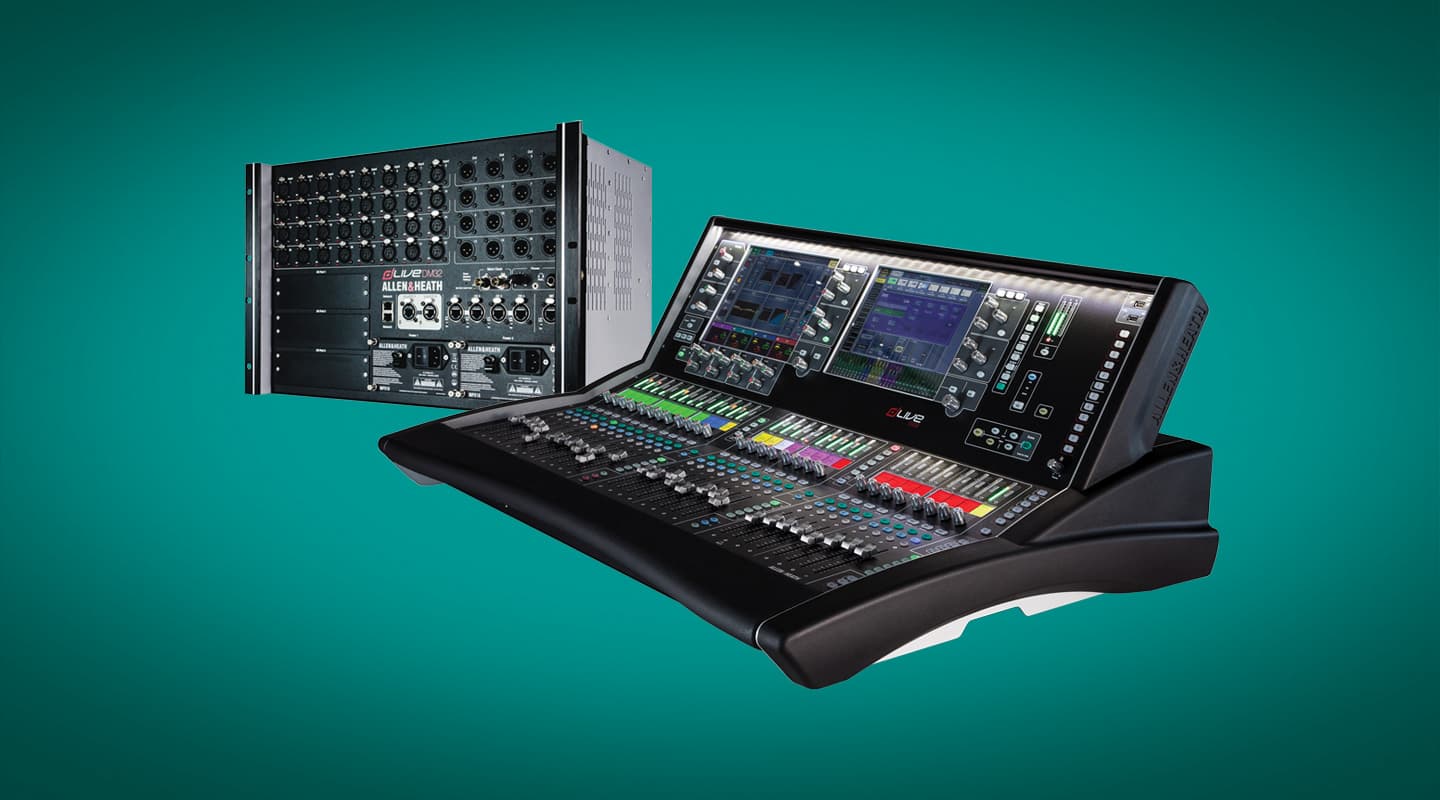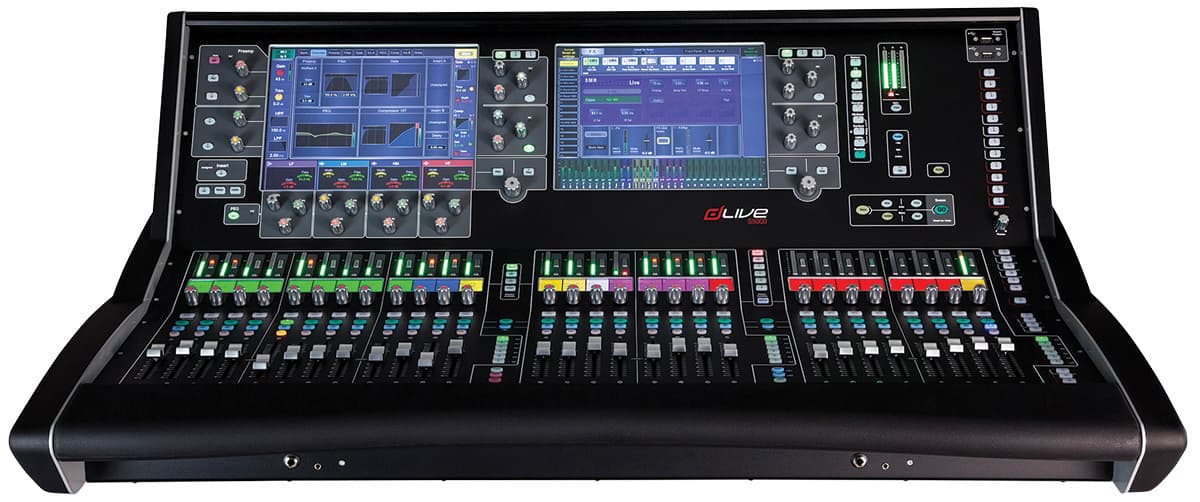
Review: Allen & Heath dLive
Allen & Heath’s dLive basically doubles everything the iLive did, for around the same price. Leaps and bounds, people!
On paper, Allen & Heath’s new flagship digital console series, dLive, looks to be tremendous value. It doubles the I/O processing power of the iLive series, with 128 x 64 fully processed I/O, and makes the leap into 96k processing. All for the price of a 4WD, not a house. Check it out for yourself, just hold up the price and specs side by side and go crosseyed like you’re doing a magic eye. At first it has the outline of a garden variety tabby, then boom, out pops a three-dimensional jungle cat! If the dLive can deliver on sound and ergonomics as it has in price and specs, it could be king of the jungle.
The dLive series comes in three console variations: the S3000 is the most compact with 20 faders and a single touch screen; the S5000 supplied for this review has 28 faders and dual touch screens; and the big kahuna S7000 ups the fader count to 36. An external screen can be connected to all of the dLive consoles which will especially please S3000 purchasers. Unlike analogue replacement-style consoles, like the Qu series, these are only control surfaces; the engine is contained in the MixRack. Let’s head down to the stage end to take a peek at the brains behind the setup.
BRAIN NOT DEFINED BY RACK
Despite there being three sizes of Mixrack in the DM series — 32 mic/line inputs by 16 line outputs, 48 x 24 and 64 x 32 — there are no dummies in the bunch. Each box has an identical mix engine, regardless of physical size or I/O. To save on cost, Allen & Heath has also developed the DX32 Expander, which adds additional I/O as either mic/line or AES3 without the brains. Up to three of those can be connected to the Mixrack or control surface.
A&H’s engineers have been busy fiddling with the XCVI core processing unit. It’s based on a new FPGA chip with enough power to handle 128 input and 64 output channels with full processing, alongside 16 stereo FX with dedicated returns. Add to that a configurable 64 bus architecture and 96k sample rate, and you’re beginning to get the picture. With latency quoted as 0.7ms and all buses time-aligned, it’s streets ahead of the iLive and almost twice as powerful as anything in its price range.
More I/O is available on the MixRack by way of three ports which offer a further 128 x 128 channels. Although full processing channels on dLive are ‘limited’ to 160 x 64 you can use the tie line feature to route any of 800 inputs to 800 outputs without using any DSP. Connection to the dLive surface is via A&H’s GigaACE protocol with dual redundancy. A quick test unplugging revealed that everything keeps rolling as you’d expect. Even when I ripped out both cables there was no disruption to the audio, and the console came back to life in seconds once I’d reconnected them.
Every component in the dLive range has the option of dual redundant power supplies. Thoughtfully, these power supplies are identical across the range so you could, for instance, have two power supplies in the Mixrack and only one in the control surface. If the control surface power supply was to fail you could borrow one from the Mixrack and the show goes on! There is also an ME port on the Mixrack for A&H’s personal mixer system.
CONFIGURABLE CONTROL
The S5000 feels comfortable the minute you sit (or stand) at it. It has a slightly curved front armrest which gives it a cockpit feel. This is more than just aesthetic as it places you closer to the touch screens where a lot of your work is done. The two screens serve separate functions; the left controls inputs, and the right handles outputs and FX. While the iLive had single channel strip-style ergonomics, the dLive departs from this by offering loads of configurable controls. The stalwart essentials like gain, hi and lo-pass filters and parametric EQ surround the input screen and get a permanent slice of screen real estate to support their functions. Almost every other control on the desk is custom configurable.
There are six user assignable soft rotary controls to the right of each touch screen with three banks available. These knobs can be configured on the fly with cleverly implemented drag ’n’ drop functionality, and the right hand strip of the touch screen follows your selection to indicate what you’re adjusting. You can even switch banks here with a flick gesture on the touch screen… you know, just in case pressing the bank button is too ’90s for ya! By default the knobs control the gate and compressor, but you can just as easily change it to FX or Monitor sends, or a dedicated control of one of your 16 stereo FX units. The recurring theme on this console is that there are many ways to get at the same controls. For instance, the rotary controls above each fader have four configurable banks as well as pan, gain and sends options. What impressed me most was how quickly you can configure these controls on the fly. Say you want control of modulation and delay time on an FX unit for a particular song. You can bring those controls to the six knobs beside the screen in an instant and start tweaking. This same high speed assigning can be achieved with fader layouts too. The S5000 surface feels fluid, almost as though it doesn’t matter where something is because you can move it without a hassle. It changes the way you mix and it’s really empowering.
NEED TO KNOW
Allen & Heath dLive
S5000 Control Surface & DM32 Mixrack

PROCESSING LIBRARY
The onboard processing is equally flexible. On top of the obligatory parametric EQ, each channel has a library of compressor options for every input and output. These are modelled on some famous analogue devices and cover both FET and opto topologies. There are also 31-band graphic EQs available on all outputs which don’t pinch any DSP processing from your 16 available stereo FX slots.
Allen & Heath has provided a wide variety of onboard FX to fill the 16 DSP slots. Once again there are some familiar looking GUIs that pay homage to analogue counterparts. I did particularly enjoy the ADT Double Tracking unit; add a little tight plate or small room and a great rock vocal sound can be had in seconds! The library is also intelligently laid out in categories, so finding the appropriate FX is a quick process.
Another feature of the S5000 worthy of mention is the listen function. When pressed, it lights up sections of the touch screen in yellow. You can choose any section to listen to in isolation, such as a compressor side chain, EQ, gate, etc. Even an aux send can be sent to your headphones in this way.
The output touchscreen also has a wealth of control options and it’s here where configuration of the console, metering, stereo ganging and scene control takes place. Once again it’s all very intuitive. If you’re really stuck on how to do anything, there is a Help button which brings comic strip-like speech bubbles to the touch screen explaining how each part works. Scene control is also particularly well implemented. Features like fade times (up to 20s) between cues and dedicated Previous, Next and Go buttons will keep the theatre fraternity satisfied.
I put this dLive system through its paces in a variety of scenarios from rock shows to theatre production and never found it wanting


SUM DO HAVE ’EM
Over a fortnight of operation, I put this dLive system through its paces in a variety of scenarios, from rock shows to theatre production, and never found it wanting. Operation is intuitive and fluid and the dLive is very much an ‘if you can dream it, it’ll do it’ console. Hell, you can even configure it to be a 60 mono send monitor desk!
The dLive’s ergonomics are outstanding and A&H’s engineers should be complimented on striking a great balance between configurability and usability. It could so easily have gone wrong, with this amount of customisation on offer, but the touch screen, drag ’n’ drop assignability, and clever management of onscreen parameters means you always feel in control.
The dLive sounds great too! The jump to 96k and the power of the processing can be heard in the reverb tails. In general, every move you make, be it pan or EQ, feels rock solid and analogue in a lot of ways. That is, you don’t feel like it’s stepping through numbers as you move controls. The tactile feel of the faders and soft rotaries are pleasant too, gliding under your fingers yet providing enough force to give great feedback. I spoke to a long term iLive user who recently purchased a dLive and uses it week in, week out for a regular gig in the same venue. He said he was prepared for his mixes to sound deeper with the dLive but was surprised by how much wider they seemed too. I have to concur.
I’m sure the dLive will find its way into a lot of venues. It’s equally at home at FOH in a pub or club as it is in a theatre or as the centrepiece of a large festival stage.
Nowadays, Allen & Heath is owned by an umbrella company called Audiotonix, which also owns Calrec and Digico. While it’s reportedly leaving the companies to operate as separate entities, judging by A&H’s move into FPGA processing there may be some collusion occurring. Digico’s promised Stealth Core 2 upgrades will bolster its lower end SD9 range, but for now the dLive will set the cat among the pigeons in big console price-to-performance. At just over $40,000 retail — for a digital package that includes 64/32 I/O fully processed at 96k, and the option to double that I/O for $20,000 — the dLive has to be heard and driven to be believed!
















RESPONSES